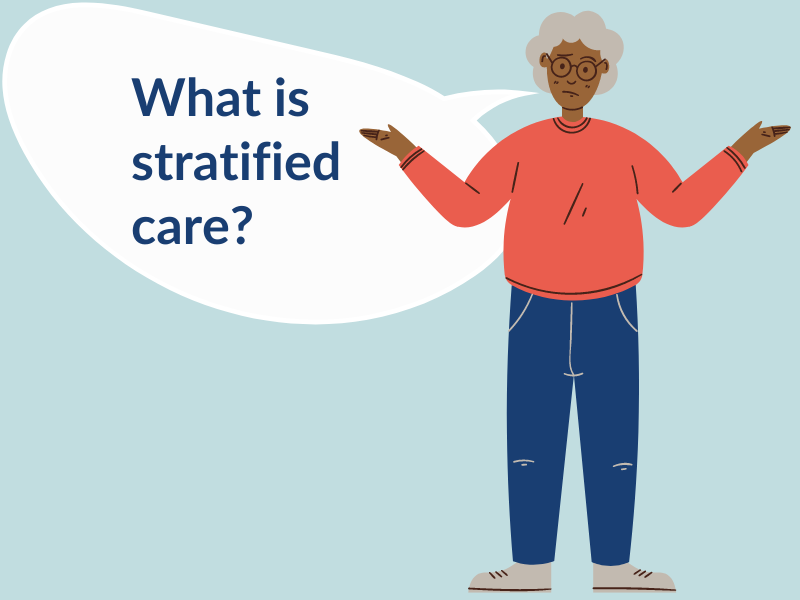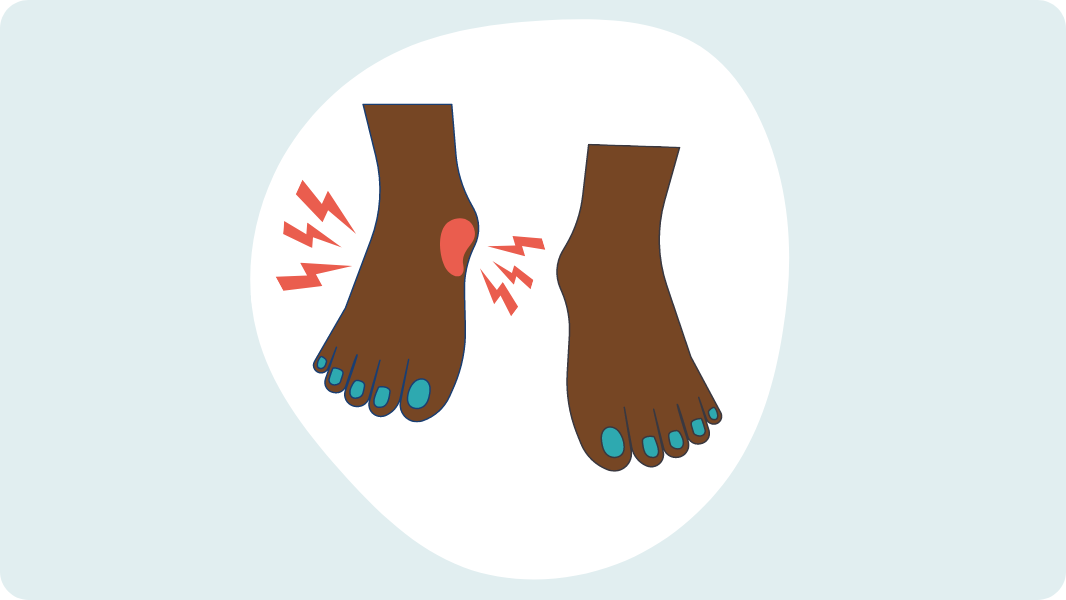Increasing numbers of people are living with long-term conditions. By 2035, projections suggest that two-thirds (68%) of adults in England aged 65 or above will have 2 or more conditions; many (17%) will have 4 or more. At a time when the NHS' primary care workforce is facing unprecedented demands, stratified care for people with long-term conditions could optimise use of NHS resources and improve outcomes.
Here, we present examples of NIHR research on stratified approaches to 4 common long-term conditions: diabetes, chronic obstructive pulmonary disease, depression and musculoskeletal conditions. This Collection will be useful to primary care clinicians and commissioners.
What is stratified care?
 The meaning of stratified care can vary. In this Collection, stratified care recognises that different groups of people, all with the same condition, may have different needs. Personal characteristics, such as age, ethnicity, other conditions or body mass index (BMI), influence decisions on the most appropriate care pathway, and how best to manage someone’s condition.
The meaning of stratified care can vary. In this Collection, stratified care recognises that different groups of people, all with the same condition, may have different needs. Personal characteristics, such as age, ethnicity, other conditions or body mass index (BMI), influence decisions on the most appropriate care pathway, and how best to manage someone’s condition.
1. Diabetes: stratified care could improve prevention and management
Approximately 4 million people in the UK have been diagnosed with type 2 diabetes; this is expected to rise to 5.5 million by 2030. Diabetes costs the NHS around £10 billion a year; most consultations for type 2 diabetes take place in primary care. Stratified care could help prevent and manage diabetes.

Ethnicity guides diabetes prevention
People from some ethnic groups are at risk of diabetes at lower BMIs than currently prompt referral.
Higher body weight is linked with type 2 diabetes, but has different effects on different ethnic groups. For example, National Institute for Health and Care Excellence (NICE) guidelines on diabetes prevention recommend weight loss programmes for white people with BMIs of 30+ but for South Asian and Chinese people with lower BMIs (of 27.5+). Research suggests that stratification based on ethnicity could be refined.
A study included almost 1.5 million adults who had not been diagnosed with type 2 diabetes. It found that South Asian, Arab, Chinese and Black people were more at risk than white people. For example, South Asian people with a BMI of 24, or Black Caribbean people with a BMI of 26 had a similar risk of diabetes to white people with a BMI of 30. The research suggests that people from many ethnic groups could benefit from diabetes prevention and weight management services at lower BMIs than would currently prompt action.

BMI, sex, and kidney function could influence choice of treatment
Information routinely collected by GPs can help identify the most appropriate treatments for people with type 2 diabetes.
In another study, researchers examined the choice of medication for different groups of people with type 2 diabetes. They explored the potential benefits of using an individual’s characteristics to influence the choice of second- or third-line diabetes treatments (medications started when first-line treatments, usually metformin, fail to control blood glucose levels).
The trial involved 525 people (taking metformin with or without a sulfonylurea). All participants took the drugs pioglitazone, sitagliptin, and canagliflozin in 16 week cycles. It showed that people with:
- a high BMI (30+) benefited more from pioglitazone than sitagliptin; those with a lower BMI benefited more from sitagliptin
- poor kidney function benefited more from sitagliptin than from canagliflozin; the reverse was true for those with better kidney function.
These results suggest that information routinely collected by GPs (BMI and kidney function) can be used to stratify people with type 2 diabetes, and identify the treatments most likely to be suitable for them. The researchers did not analyse how overlapping characteristics influenced the effectiveness of medications, such as having a high BMI and poor kidney function. They said that with more research this could be done in future leading to more refined stratification.
A database study, involving more than 22,000 people, stratified patients in other ways. It showed that for:
- men with a BMI less than 30, sulfonylureas were more effective than thiazolidinediones
- women with a BMI 30+, thiazolidinediones were more effective than sulfonylureas.
GPs could discuss these findings with patients when deciding on medication.

Do people at low risk of ulcers need an annual foot check?
Research suggests that screening people at low risk of foot ulcers every 2 years instead of annually could save the NHS time and money.
Foot ulcers are a major complication from diabetes that GPs aim to predict and prevent. Research evidence could help GPs do this and save resources.
For example, NICE guidance recommends using 8 to 10 tests to assess the risk of a foot ulcer. Researchers developed an accurate tool that requires only 3 pieces of information and is simpler and quicker to carry out. The information required is: a pulse in the foot, previous ulcers or amputation, and the monofilament test (which measures ability to feel a single strand of nylon).
“A simple calculation of risk factors determines whether someone is likely to have a foot ulcer. Finding the people at greatest risk will help them access the right treatments. Overall, this could represent a huge cost saving to the NHS.” – Amy Harwood, Researcher, Coventry University
NICE guidelines recommend that people with type 2 diabetes have an annual assessment for risk of foot ulcers. Other research suggests that these foot checks could be scaled back. It found that few (5%) people at low risk progressed to medium risk after two years. Fewer still (0.4%) developed ulcers in that time. Screening people at low risk every 2 years instead of annually could save time and money.
NICE reviewed both of these foot ulcer studies but did not include the findings in the 2023 update of guidelines. This was partly because of insufficient evidence about the tool’s use in practice and also because more frequent checks offer an opportunity to teach people how to look after their feet.
2. Chronic obstructive pulmonary disease: stratified care guides treatment choices
In the UK, 1.2 million people have chronic obstructive pulmonary disease (COPD); flares (exacerbations) account for 1 in 8 emergency hospital admissions. By 2030, almost 1.7 million are projected to have COPD; this will cost the NHS £2.5 billion a year. Stratified care could help guide treatment.

Blood test reduces steroid prescriptions for COPD
Steroid prescriptions for COPD flares could be guided by a patient’s eosinophil (a type of white blood cell) count, research suggests.
Prednisolone, an oral corticosteroid (steroid), reduces inflammation and is recommended to treat COPD flares. However, it has been linked with weight gain, sleeping problems and mood changes.
COPD is driven by inflammation of the lungs. Research suggests that higher levels of eosinophils (immune cells) increase the risk of COPD flares and also predict the effectiveness of inhaled steroids at preventing the onset of flares. International guidelines recommend assessing blood eosinophils levels (which are commonly collected as part of a full blood count) before prescribing inhaled steroids, but this is not routinely done in UK practice.
Recent research explored whether eosinophils can also predict the effectiveness of oral steroids as treatment.
A randomised controlled trial in primary care assessed whether prednisolone treatment for COPD flares could be based on blood eosinophil levels. All participants received antibiotics, and in addition, half (76) received usual care (prednisolone). The others (76) received prednisolone only if their eosinophil count was 2% or higher.
Treatment failures (retreatment with steroids or antibiotics, hospitalisation or death) and adverse events were similarly likely in both groups. However, prednisolone prescriptions were reduced by 33% in the group whose eosinophil count was checked compared with the usual care group. This suggests that this blood test could effectively reduce prednisolone prescriptions (and their associated side effects) during COPD flares, the researchers say.

Frailty predicts worse outcomes from COPD
Integrating frailty assessments into routine COPD care could identify those most at risk and inform treatment choices.
A UK Biobank study involving 3,132 people with COPD (aged 40–70) found that many had frailty (28% moderate; 4% severe). Frailty was linked with a higher risk of death, and major heart problems. The researchers suggested that integrating frailty assessments into routine COPD care could inform the choice of the most appropriate interventions.
In addition to frailty, people with COPD frequently have other long-term conditions, such as heart failure, that put them at risk of worse outcomes. A primary care database analysis involved 50,000 people with heart failure; 18,478 of them also had COPD. It found that COPD increased the risk of hospital admission and death. This was especially true for people on the most intense COPD medications: triple inhaler therapy, oral corticosteroids, or oxygen therapy. In addition, the severity of people’s COPD increased the risk of death. To improve these poor outcomes, the researchers suggested that people with heart failure and the most severe forms of COPD need early intense treatment and close monitoring.
These studies show how stratified care considers the interaction between different conditions to identify those most at risk and helps clinicians choose the most appropriate treatment.
3. Depression: stratified care suggests new approaches to treatment
In 2022, more than 1 in 10 (16%) adults in Great Britain experienced moderate to severe depressive symptoms. The standard approach of stepped care does not meet the needs of everyone; new stratified approaches could improve care for people with depression.

High-intensity treatments could be fast-tracked for those at highest risk
People with depression usually start with low-intensity treatments, which are scaled up if symptoms persist. Research suggests it may be more effective to stratify people based on their risk of a poor outcome, and offer the most appropriate treatment straight away.
In England, care for depression is usually stepped, starting with low-intensity treatments (such as self-help) before moving on to more intensive therapies if symptoms persist. This model is effective for most people, but certain groups have worse outcomes, such as people with disabilities and those from deprived backgrounds. A stratified approach assesses people first, and then offers low- or high-intensity treatments based on their risk of poor treatment outcomes.
In a randomised controlled trial, participants were initially assessed by a clinician. One group (368 people) then received standard stepped care. The others (583) received stratified care. Their risk of poor outcome was assessed by artificial intelligence, based on data on their depression, anxiety, personality traits, employment status, disability, ethnicity and race. The treatment recommendation was based on their risk.
After treatment, more people in the stratified care group (52%) had meaningful improvements in their depression symptoms compared with the stepped care group (45%). Stratified care cost £104 more per patient than stepped care, because more people had high-intensity treatments. The researchers say stratified care could improve outcomes for depression at a modest additional cost. In an ongoing study they are exploring the long-term effectiveness and value for money offered by stratified care.

Can we predict who will have poorer long-term outcomes?
Following treatment in primary care, people’s risk of long-term depression or relapse might be predicted using routinely collected data such as the severity of someone's depression and their age. This could help GPs plan treatment, but more research is needed.
An analysis of 7 randomised controlled trials of treatment for depression in primary care settings used data from individual participants. Researchers stratified people according to characteristics such as age, comorbidity, employment status, duration of illness and treatment history. The resulting 7 groups included a low severity group, an older unemployed group with long-term illness, and a group with very severe symptoms and long-term illness.
The researchers found significant differences between groups in how likely people were to have poorer long-term depression outcomes, including a relapse of their symptoms. This suggests it could be possible to identify groups of people whose illness is more or less likely to follow a particular course. The information might help GPs plan treatment. Some might need more intensive treatments to prevent depression becoming long-term, or psychological therapies that aim to prevent relapse; others might recover well with self-help advice alone. However, this research is at an early stage and further work is needed to determine whether the predictions could usefully inform the management of depression.
Ongoing NIHR research on stratified care for depression includes a study exploring whether people can be matched with the antidepressant they are best suited to. Another is seeking to develop a tool to predict the risk of treatment relapse.
4. Musculoskeletal conditions: stratified approaches have mixed results
Musculoskeletal conditions (of joints, bones and muscles) include rheumatoid arthritis, back pain, and osteoporosis. More than 20 million people in the UK have a musculoskeletal condition, and 30 million working days are lost every year as a result. They account for almost 1 in 3 GP consultations in England. Some stratified approaches for musculoskeletal conditions have shown promise, but others have had mixed results.

Blood tests could be offered less frequently for some people with rheumatoid arthritis
Routinely collected data was used to predict the risk of toxicity from common treatments for inflammatory conditions such as rheumatoid arthritis. The research suggested that those at low risk could be monitored less frequently.
“GP surgeries are under a lot of strain, so reducing the frequency of blood test monitoring for certain patients might lessen this. It could also make a difference to patients themselves, who may have to arrange blood tests well in advance, take time off work to go, then chase the surgery to pass results to their consultant.” – Camila Garces-Bovett, Public Contributor, South West England
Stratified approaches to inflammatory musculoskeletal conditions have shown promise. For example, people starting on methotrexate (a common treatment for rheumatoid arthritis) have blood tests every 3 months for blood, liver, or kidney toxicity, even though these side-effects are uncommon during long-term treatment. A primary care database analysis included almost 37,000 people with inflammatory conditions (including rheumatoid arthritis). It found that the risk of methotrexate toxicity could be predicted using routinely collected data. This could mean that people at high risk of toxicity could be monitored more frequently; those at low risk, less frequently. Increasing the interval between blood tests could save time for patients and GPs, and have cost savings for the NHS.
Other analyses in the same project had similar findings for other treatments for rheumatoid arthritis (including thiopurines , anti-tumor necrosis factors (TNFs), leflunomide, and sulfasalazine). In addition, increasing the interval between blood tests from 3 months to 2 years for those at low risk of thiopurine toxicity, was likely to be cost-effective.
An interview-based study involved 18 people taking immunosuppressants, plus 13 clinicians. Participants said that frequent blood tests were burdensome and put unnecessary pressures on NHS resources. They supported the increased interval between tests and were happy for their clinician to set an interval based on their risk, with the option to change if necessary.

Does stratified care help people with musculoskeletal pain?
Researchers developed one tool to stratify people with pain of the back, neck, shoulder and/or knee, and another for those with sciatica. Different groups of people were matched to appropriate treatments. Neither of these approaches to stratified care improved outcomes.
Research by Versus Arthritis developed a tool (STarT Back) to stratify people with low back pain to matched treatments, based on their risk of a poor outcome (high levels of pain or disability, for instance). Those at greatest risk were referred for physiotherapy combined with elements of cognitive behavioural therapy, those at medium risk were referred to exercise-based physiotherapy, and those at low risk to less intense treatment (supported self-management). Stratified care reduced disability related to back pain compared with usual care, and was cost effective. It is now recommended in NICE guidelines for low back pain.
Following the success of this work, the research team adapted the STarT Back tool for people with a broader range of musculoskeletal pain (including back, neck, knee and shoulder pain, and pain in multiple sites). In a randomised controlled trial, more than half (677 people) were offered usual care (treatment at GP’s discretion); others (534 people) were offered an adapted approach to stratified care (the STarT MSK tool and matched treatments).
In the stratified care group, GPs used the STarT MSK tool to assess people’s risk of a poor outcome. Each subgroup (low, medium, or high risk) was then offered treatment from a small set of options according to their risk. For example, self-management advice for the low risk subgroup, physiotherapy for the medium risk subgroup, referral to a pain management service for people in the high risk subgroup.
The STarT MSK tool accurately predicted people’s risk of a poor outcome. However, at 6 months follow up, pain levels and costs were similar regardless of whether they were in the usual or stratified care group. Stratified care had some positive effects; it increased GPs’ provision of written self-management advice, and both patients and clinicians gave positive feedback.
The same researchers adapted the STarT Back approach to stratified care for people with sciatica (pain, weakness, or numbness in the bottom, leg or feet). In a similar randomised controlled trial, 238 people were divided into 3 subgroups according to their risk of a poor outcome. They were offered matched treatments: supported self-management in up to 2 treatment sessions (people at low risk), a course of physiotherapy (medium risk) or a fast-track MRI scan with a specialist appointment to consider more expensive treatments (high risk). The other 238 people received usual care. The trial found no difference between usual and stratified care in the time taken for people’s sciatica symptoms to resolve.
Neither study (broad range of pain; sciatica) therefore supported a stratified approach. However, in a recent review, the researchers argue that stratified care is not yet well-enough implemented to have been given a fair test. They say that in primary care, the approach improves decision-making and reduces low-value care. But it will only improve patient outcomes when care pathways are in place to match people, especially those with complex needs, to appropriate treatments.
Conclusion
Research demonstrates that stratified care is not a silver bullet and does not always add benefit. Stratified care needs to be supported by strong evidence and well-defined care pathways before it is implemented in practice.
This Collection therefore presents examples of research in which stratified approaches to the management of long-term conditions in primary care:
- optimised disease prevention
- personalised treatment options
- reduced the use of potentially harmful medications
- reduced the burden of monitoring for patients and clinicians.
All of the above could improve outcomes for patients; some could save NHS resources. GPs and commissioners could use this evidence to make better use of stratification in primary care.
Author: Brendan Deeney, Science Writer, NIHR
How to cite this Collection: NIHR Evidence; Can stratified care help GPs manage long-term conditions?; September 2024; doi: 10.3310/nihrevidence_63807
Disclaimer: This Collection is based on research which is funded or supported by the NIHR. It is not a substitute for professional healthcare advice. Please note that views expressed are those of the author(s) and reviewer(s) at the time of publication. They do not necessarily reflect the views of the NHS, the NIHR or the Department of Health and Social Care.
NIHR Evidence is covered by the creative commons, CC-BY licence. Written content and infographics may be freely reproduced provided that suitable acknowledgement is made. Note, this licence excludes comments and images made by third parties, audiovisual content, and linked content on other websites.